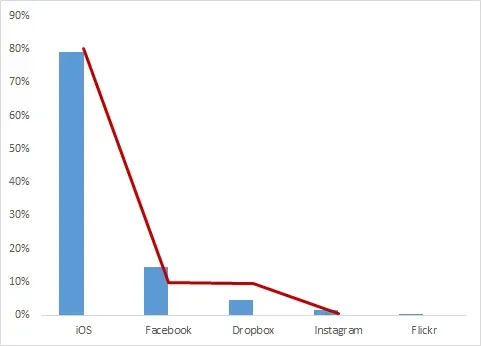How People Use Photos To Create On iPad

As head of product at Impressed, I’m fascinated by creating an awesome mobile business with photo products people love. One of the techniques I’ve focused on is gathering lots of data on how users use our product to make it better, easier, and just plain fun.
Impressed
First, some context: Impressed is an iPad app that allows you to create voice-enabled photo books on your iPad in minutes. Our goal is to make your photo memories more permanent more quickly, in a beautiful modern way so that they become decor items in your home.
We launched Impressed officially on October 1, 2013 in San Francisco at Launch: Mobile & Wearables. Since then, we’ve had time to amass some analytics regarding how our users use their iPads to create photo books. We thought we could share some of our experiences for other startups in the photo space and other nerdy data people like me. By the way, we are available at the moment in Canada and the US only, so our data reflects this fact. Also, keep in mind that, at the moment, Impressed is iPad only.
So what have we found as we optimize our product for our customers? Here are a few key insights.
Photos & Where They Come From

First, let’s see where our users get their photos from for printing. The graph above has two layers to interpret. The blue bars represent the photos our users have accessed from a given data source to make a book, but not necessarily printed. The red line, on the other hand, represents the photos from a given source that are actually used to print a book. So, basically, the red line shows you how many actual books were printed (as a proportion — which is why Dropbox looks wacky) using photos from a given data source.
Not surprisingly, most photos accessed and printed are from iOS, i.e., they are actually on the iPad (80%). On the other end of the continuum, our users may access Flickr to check out their photos, but they never actually print using Flickr photos. Our Instagram users do not use many of their photos, but when they get them, they print with them. The most interesting groups are the Facebook and Dropbox users. Users who grab Facebook photos are less likely to print using those photos; conversely, users with Dropbox photos are more judicious about the photos they use, but they tend to print with them.
This all makes some sense: iOS and Dropbox photos tend to be a higher quality, so they print well, and Facebook is where a lot of photos tend to be, so one might look there if they didn’t have photos sitting around on their iPads.
Cameras

Next, let’s look at the cameras our users use when they print. Since photos contain metadata, they sometimes report what camera was used to take the photos themselves. For those that do, we grouped them into the chart above. As you can see, the iPhone continues to be the number one camera for photography (the iPhone 4S to be precise, followed by the iPhone 5, then the iPhone 5S; the iPhone 5C is almost nowhere to be seen). DSLRs come a very close second, followed by point and shoot cameras, followed by the iPad. Yes, it seems that people are printing photo books from photos they took on their iPads. Surprising? That was surprising to us too!
When People Create Photo Books

Finally, we sliced our data via time. Though our users follow common iPad usage patterns, we found that our users primarily attempted to make photo books consistently late in the evenings. On weekends, our users spend more time on their books in the afternoons and early evenings as well. We have a few blips where our customers are spending time at 11 am on a Friday and 2 pm on a Monday making their books. But, all in all, evenings and weekend afternoons are key for our customers.
What Does It All Mean?
Sadly, I can’t derive the meaning of life from this information just yet. But what we do see is that people:
- want access to photos from the most popular camera in the world, the iPhone,
- are creating with intention, not haphazardly, and
- tend to be most creative in the late evening, with the weekend being the photo hotspot
Knowing all of this this has allowed us to:
- anticipate communicating with and supporting our customers when they are the most creative,
- work on optimizing our product to accommodate where people are spending the most time to make our product faster and better, and
- come up with some really clear solutions — rather than pure instinct — to help our customers where their photos actually are, the iPhone (more to come on that front!)